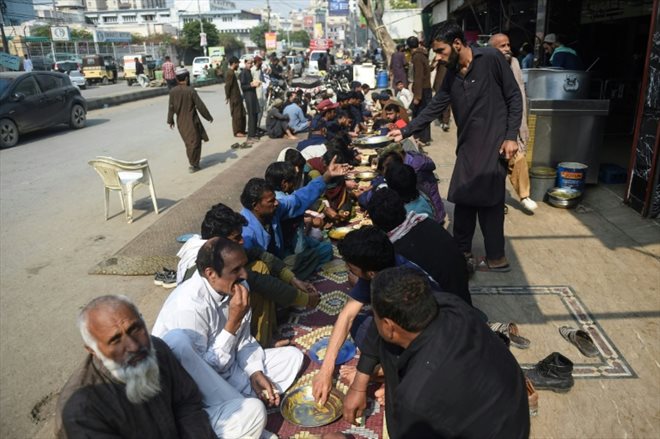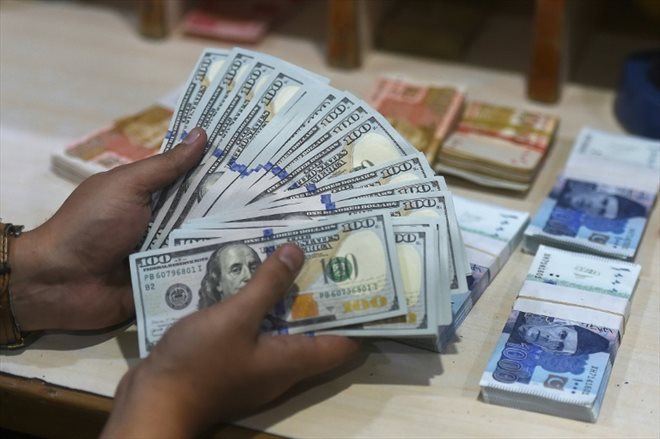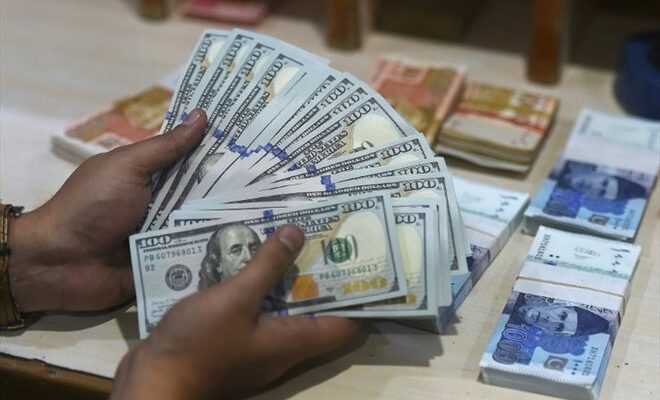Inside a store in Karachi where screens display the exchange rates of several foreign currencies on January 11, 2022 (AFP/Asif HASSAN)
Maira Tayyab considered begging to feed her family and Mohammad Hanif does not hide being tormented by criminal thoughts. In Pakistan, galloping inflation is overwhelming the population and weakening the Prime Minister, Imran Khan, one year before the elections.
Maira and Mohammad are both too proud and honest to let their impulses run wild. But their torments are shared by millions of Pakistanis.
“We can’t beg, we are white-collar workers,” said Maira, a 40-year-old housewife living in Karachi, a port megalopolis in southern Pakistan and the country’s financial capital. “But we don’t know how to make ends meet,” she told AFP.
Inflation will hit 10% in 2021, according to the World Bank. The cost of some basic products has soared: the price of a liter of gasoline has increased by 45% in one year and that of a liter of cooking oil by 130% since 2018.
Kursheed Sharif, 50 and mother of five, is just as desperate as Maira. “Death seems the only alternative to survival under this government”, she gets carried away, on the verge of tears, in the miserable accommodation she rents in Karachi.

Distribution of free meals in the streets of Karachi, January 10, 2022 (AFP / Rizwan TABASSUM)
Imran Khan and his party, Pakistan Tehreek-e-Insaf (PTI), came to power in 2018 promising to end decades of corruption and nepotism, and create an Islamic welfare state with a tax system. more effective in funding social programs.
But his inability to keep this commitment is already being felt in the polls. And in December, the PTI suffered a resounding defeat in provincial elections in its stronghold of Khyber Pakhtunkhwa (north-west).
“The government brags about its economic prowess, but in reality it is on the back foot and has lost its credibility,” said Tauseef Ahmed Khan, a political commentator.
– External debt –

At a Karachi market on January 10, 2022 (AFP / Rizwan TABASSUM)
Analysts admit that the former cricket champion had inherited a very delicate situation and that the Covid-19 pandemic did not help him. But they also question his choices.
“Nothing is stable,” worries Rashid Alam, who works for an international bank in Karachi. “Rising unemployment and inflation (…) is the political and economic reality in Pakistan.”
While economic growth could stand at 4% in 2022, it has remained practically nil for the past three years.
The rupee has depreciated sharply, by 12% against the dollar since July, due in particular to a trade deficit of 5 billion dollars (4.3 billion euros) and this despite the 10% increase in shipments in currencies of its diaspora.

Sacks of rice are unloaded at a market in Karachi on January 10, 2022 (AFP/Rizwan TABASSUM)
Mr Khan objected last week that Pakistan’s economic problems, particularly inflation, are not specific to it and that it remains “one of the cheapest countries” in the world.
The manufacturing and services sectors seemed to rebound with the removal of Covid-related containment measures. And agriculture should benefit from more abundant rains this year.
But the other major problem of the Pakistani economy is the repayment of an external debt which stands at 127 billion dollars.
– Mini-budget –
Mr. Khan had succeeded in obtaining in 2019 from the International Monetary Fund (IMF) a staggered loan of 6 billion dollars. But only a third has been disbursed and the IMF has blocked the rest until the Pakistani government implements the reforms to which it was committed.
To secure the release of another $1 billion at a meeting scheduled for this month, the government presented a mini austerity budget, which plans to end tax exemptions on products staples and foodstuffs.

In a currency exchange office in Karachi, January 11, 2022 (AFP / Asif HASSAN)
The opposition, which fears that these measures will lead to a further increase in prices, has announced several large marches against the government in the coming weeks.
On the verge of default, Pakistan recently secured loans of $3 billion each from China and Saudi Arabia, and $2 billion from the United Arab Emirates.
“All loans that are taken out now, wherever they come from, are intended to repay previous loans,” said Qaiser Bengali, an independent economist. “Essentially the economy is bankrupt. Pakistan cannot repay its loans.”
The government has to deal with a very low tax collection rate. Less than two million people paid their dues in 2020, out of a population of 220 million. Less than 10% of GDP is thus derived from tax revenues.
In his small car battery repair shop, Mohammad Hanif harbors the darkest ideas. “Thoughts (criminal) occupy my mind about how to make ends meet. But I fear Allah, so I push them away,” he admits.
© 2022 AFP
Did you like this article ? Share it with your friends with the buttons below.




